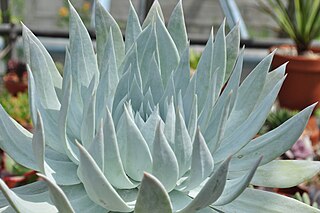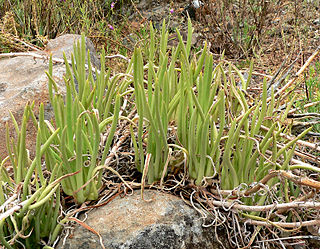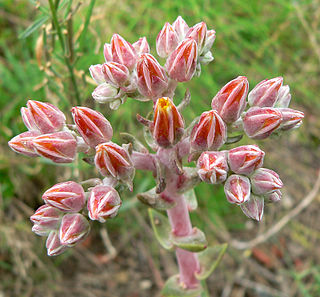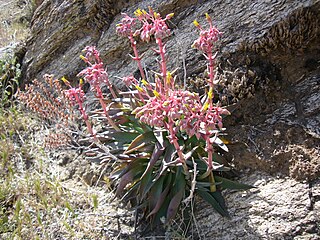 W
WDudleya is a genus of succulent perennial plants, consisting of about 45 species in southwestern North America.
 W
WDudleya abramsii is a succulent plant known by the common name Abrams' liveforever. The epithet abramsii commemorates LeRoy Abrams. It is native to California and northern Baja California, where it grows in rocky areas in a number of habitat types. It is a fleshy perennial forming a small basal cluster of leaves around a central caudex. The thick, waxy leaves are triangular to oblong and usually pointed, reaching up to 11 centimeters in length, but often remaining much smaller. The entire rosette is generally only a few centimeters wide. The inflorescence is a mostly erect, branching stem lined with pointed bracts and bearing up to 15 flowers. The flower has five small, thick sepals at the base of five pale yellow petals each about a centimeter long.
 W
WDudleya abramsii subsp. parva, the Conejo dudleya, is a perennial herb which is native to Conejo Valley and surrounding regions. It blooms from May-June, and is only found from the western end of Simi Hills to Conejo Grade in Newbury Park. It is a threatened succulent species which is found throughout Conejo Valley but also in western Santa Monica Mountains.
 W
WDudleya anthonyi is a succulent plant from Isla San Martín and the adjacent mainland of Baja California, where it is found in the rocky foothills.
 W
WDudleya blochmaniae is a succulent plant known by the common names Blochman's liveforever or Blochman's dudleya.
 W
WDudleya brevifolia, is a rare succulent plant known by the common name short-leaved liveforever or short-leaved dudleya. It was formerly a subspecies of Dudleya blochmaniae.
 W
WDudleya brittonii, with the common names Britton's dudleya and giant chalk dudleya, is a succulent plant in the family Crassulaceae. It is native to Baja California, Mexico.
 W
WDudleya caespitosa is a succulent plant known by several common names, including sea lettuce, sand lettuce, and coast dudleya. It is endemic to California, where it grows along the coastline in the southern half of the state.
 W
WDudleya candelabrum is a succulent plant endemic to California, where it grows wild only on the northern Channel Islands.
 W
WDudleya cymosa is a succulent plant known by the common name: canyon live-forever. The plant is found in rocky areas in the low elevations of California and southern Oregon mountains.
 W
WDudleya edulis is a succulent plant known by the common name fingertips.
 W
WDudleya farinosa is a succulent plant known by several common names, including bluff lettuce, powdery liveforever, and powdery dudleya.
 W
WDudleya gnoma is a rare species of succulent plant in the stonecrop family known by the common names munchkin liveforever and munchkin dudleya. It is endemic to Santa Rosa Island, one of the Channel Islands of California, where it is known from one single population containing about 3200 plants. The population was discovered in the 1950s and assumed to be a relative of Dudleya greenei, a plant also occurring on the island which is similar but larger and contains the same number of chromosomes. The plant was not described to science until 1997. The population is protected from nearby grazing cattle by a fence. It still faces threats from deer, which can get past the fence, a limited gene pool, and the fact that a single severe event such as a drought, could eliminate the single population. Though rare in the wild, this dudleya is kept in cultivation by gardeners and enthusiasts of succulents, and a cultivar called 'White Sprite' is popular.
 W
WDudleya greenei is a rare succulent plant known by the common names Greene's liveforever, or Greene's dudleya. It is endemic to the Channel Islands of California, where it grows along the cliffs of four of the eight islands.
 W
WDudleya hendrixii is a flowering plant discovered in late 2016 by researchers from San Diego State University and University of California, Santa Cruz. Having upright, waxy, terete leaves, the plant is only found on a few acres of the Colonet Peninsula of Baja California, Mexico. This thin, stalky plant grows to about 1 ft (0.30 m) tall, and has bright pink and white flowers. Dudleya hendrixii is summer deciduous, dying in the summer only to re-sprout in the fall.
 W
WDudleya ingens, commonly known as Baja liveforever, is a species of Dudleya that grows to an average height of 12 in (30 cm) and a width of 12 in (30 cm).
 W
WDudleya lanceolata is a succulent plant known by the common name lanceleaf liveforever. This plant is native to the mountains of Southern California and Baja California, where it is found in rocky areas and slopes.
 W
WDudleya nesiotica is a very rare succulent plant known by the common name Santa Cruz Island liveforever. This Dudleya is endemic to Santa Cruz Island, one of the Channel Islands of California. This is a squat plant growing in mats on the rocky, exposed ground of the windswept island. It is a federally listed threatened species.
 W
WDudleya palmeri is a succulent plant known by the common name Palmer's liveforever. This Dudleya is endemic to California where it grows along the coastline of San Luis Obispo and Santa Barbara Counties southward.
 W
WDudleya pulverulenta is a succulent plant known by the common names chalk lettuce, chalk dudleya, and chalk liveforever.
 W
WDudleya saxosa is a perennial succulent desert plant in the family Crassulaceae, commonly called live-forever'. This dudleya is native to the rocky slopes of the Peninsular Ranges and the sky islands in Mojave Desert mountains, such as the Panamint Range, in Southern California, and in Baja California and Arizona.
 W
WDudleya setchellii, the Santa Clara Valley dudleya, or Santa Clara Valley liveforever, is a member of the Dudleya genus of succulent perennials, members of the family Crassulaceae. The Santa Clara Valley dudleya, endemic to the Santa Clara Valley region in the southern San Francisco Bay Area, was listed on February 3, 1995, as an endangered species. It is sometimes considered to be a subspecies of Dudleya abramsii.
 W
WDudleya stolonifera is a succulent plant known by the common name Laguna Beach liveforever. This is a rare plant which is endemic to the coastline of Orange County, California. It is known from only about six populations in the vicinity of Laguna Beach, totalling about 30,000 individuals. It is federally listed as a threatened species of the United States.
 W
WDudleya traskiae is a rare succulent plant known by the common name Santa Barbara Island liveforever. This Dudleya is endemic to Santa Barbara Island, one of the Channel Islands of California, where it grows on rocky bluffs. The plant has a basal rosette of flat, spade-shaped fleshy leaves up to 15 centimeters long, which are pale green to yellowish. It erects tall stems bearing dense, rounded inflorescences of many bright yellow flowers.
 W
WDudleya verityi is a rare species of succulent plant known by the common name Verity's liveforever. It is endemic to Ventura County, California, where it is known from only three occurrences in the vicinity of Conejo Mountain between Camarillo and Thousand Oaks. It probably occurs in a few additional locations nearby which have not yet been officially vouchered.
 W
WDudleya virens, the green liveforever or bright green dudleya, is an uncommon species of perennial, succulent plant in the family Crassulaceae, native to several coastal southern California and Baja California locations.
 W
WDudleya viscida is a rare succulent plant known by the common name sticky liveforever.